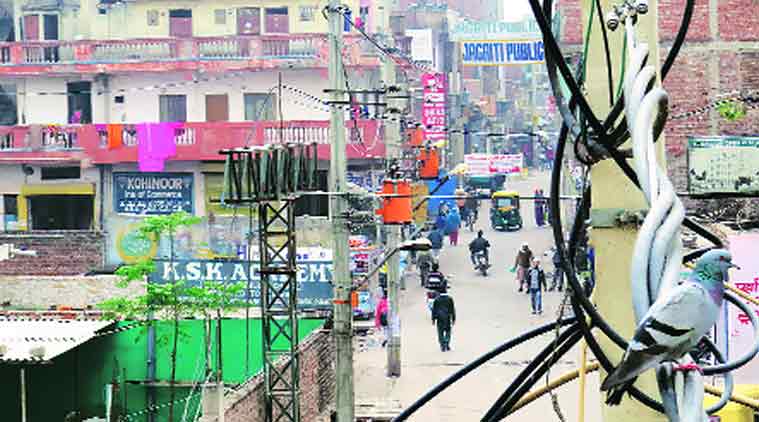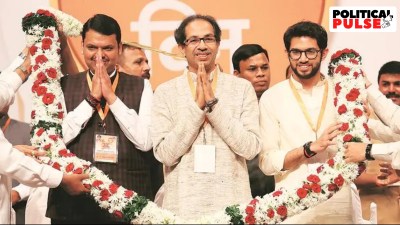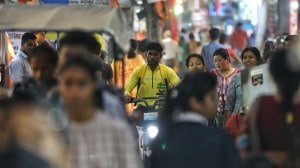- India
- International
All parties love this illegal colony: Its people don’t count, their votes do
The Indian Express reporter Ashutosh Bhardwaj moves into Asia’s largest unauthorised colony to track the battle for the capital.
 AAP swept through this area in 2013. (Source: Express Photo by Ashutosh Bhardwaj)
AAP swept through this area in 2013. (Source: Express Photo by Ashutosh Bhardwaj)The Indian Express reporter Ashutosh Bhardwaj moves into Asia’s largest unauthorised colony to live there — and track the battle for the capital. From a room on top of a garment factory.
“What is the probability that a coin…” Before Maths teacher Pappu Kumar Jha can complete the sentence, his voice is drowned by the noise of an election convoy, momentarily halting his tuition class on the terrace of a market in Sangam Vihar.
Jha is from Bihar’s Madhubani where, he says, elections are fun, and students and teachers would rush out to catch a glimpse of the action. But not here. Not in Asia’s biggest unauthorised colony, where the battle for control of India’s capital has hardly created a ripple.
Even Jha, who says he is crazy about politics, quickly returns to his lessons. “Elections? Government? Is Sangam Vihar really a part of India?” he asks later, laughing. Jha came here in 1994 and seven years later, purchased a 50 sq yard “home”. Today, he is a teacher at the local Jagriti Public School.
Real estate agent Sudheer Agrawal is more blunt. “An area can be a part of India only when Indian laws are applicable there,” says Agrawal, the owner of Radhey Krishna Properties.

And yet, during every election, Sangam Vihar emerges as one of the most hotly contested enclaves in the city. Nothing is on paper here and yet the political battlelines are etched in stone. It doesn’t matter whether it’s Narendra Modi’s BJP, Sonia Gandhi’s Congress or Arvind Kejriwal’s AAP — when it’s election time, all parties, no matter what they stand for, love this illegal colony.
In 2008, the then CM Sheila Dikshit’s promise to regularise the nearly 1,600 such unauthorised colonies in Delhi won the Congress the elections. But then nothing happened, and AAP swept through these illegal pockets, reducing the Congress to just eight seats from 43. Their importance has not been lost on the BJP either, which has been quick this time to woo the voters here.
Obviously, Sangam Vihar’s votes count, even if its people don’t.
“The government is absolutely absent here. No tax applies here. No house tax, no water tax, no wealth tax,” says Kalicharan Sharma, BJP councillor from ward no 186, one of the four in this constituency that first started taking shape as a kind of urban slum in the 1980s.
Behind this cynicism are some numbers which add up to this disturbing reality: if participation in elections is the yardstick of any democracy, Sangam Vihar falls short by quite some distance. Consider these:
The constituency is part of the elite South Delhi Lok Sabha seat but has probably the lowest voter to total population ratio in the country. In the 2013 Assembly polls, Delhi had 1.19 crore voters, or, 66.6 per cent of the total population of 1.78 crore. At the same time, Sangam Vihar constituency had a mere 1.37 lakh registered voters, just 13.7 per cent of its estimated 10 lakh residents. The colony, as such, has an estimated 12-15 lakh residents of whom a small portion vote for the adjoining Deoli seat.
As a colony, Sangam Vihar houses over 6.7 per cent of Delhi’s population, but only around 1.5 per cent of its voters. Now, compare this to Bastar in Chhattisgarh: the 12 constituencies of this remote Maoist-hit corner have 19.2 lakh voters of a total population of nearly 40 lakh — nearly 50 per cent . Even the sparsely populated Narayanpur, which includes another Maoist hotpsot Abujhmaad, has 1.6 lakh voters.
An Election Commission official, however, dismisses the estimate of 8-10 lakh residents here, saying “it is not possible”.
“When delimitation was done on the basis of the 2001 census, Sangam Vihar had a population of 2 lakh. It would have increased to a maximum of 3 lakh now. A population of 8-10 lakh is not possible there. We gave electoral rolls to political parties, organised several camps for revising the rolls and included more voters. If there was so much population, it would have surfaced,” S K Mendiratta, Legal Advisor to Election Commission of India, told The Indian Express.
But residents and local politicians point out that Sangam Vihar saw a sudden and massive influx of people after 2005, the year it got electricity for the first time. While former Sangam Vihar BJP MLA and present party candidate Dr S C L Gupta estimates the population of the constituency to be nearly 10 lakh, BJP councillor Sharma puts it around 8 lakh.
BJP’s South Delhi MP Ramesh Bhidhuri offers a logical reason for this “under-representation” of voters. “Most of the residents here are tenants and do not get voter cards. Only those having a permanent address will have voter cards,” says Bhidhuri.
Dr Gupta, who has been working in the area with his wife for nearly three decades, says, “Many residents do not have any valid document as address proof so they don’t get voter cards.”
There’s another reason why 87 per cent residents here do not have voter cards. They just don’t want to vote because there’s hardly any connect with the state — social, political or emotional. In fact, the only queue that you will see here for a government ID is for an Aadhar card, and that too, because it’s linked to LPG connections.
Living beyond the ambit of government schemes, it’s their mark of protest against a state that appears to have abandoned them.
This disconnect can be traced right back to when and how Sangam Vihar was born. This land, enclosed on three sides by forests and the Asola Wildlife Sanctuary, was sold by the original claimants — mostly Gujjars and Jats — to private individuals in the early 1980s. Subsequently, migrants from UP and Haryana and Bihar started settling here. The land deeds were never officially authorised and the colony soon became a shelter for the immigrant population. Sangam Vihar was a part of Tughlakabad constituency before a separate seat was carved out in 2008.
The area is packed with medium-sized shops that sell electronics, medicines, construction material, etc., of which only a few offer cash memos. Nobody asks for a receipt and transactions are conducted without bills. Shopkeepers don’t want to be named but Agrawal says, “At least 80% of shop owners have no VAT numbers. You can conduct a survey.”
The only tax that exists here is on personal income even though many do not have even PAN cards. Vinod Yadav, from UP’s Pratapgarh in UP, says he pays Rs 14,000 as monthly rent for his photo studio, and that his two kids study in a local school. But he does not have a VAT or PAN card, both of which are officially mandatory. “Kachchi colony hai, koi tax nahin lagta (This is a half-baked colony, there are no taxes here),” he says.
Sukhnandan Jain, the owner of a ladies garment shop, among the biggest here, admits that he doesn’t know what VAT is. He has no PAN card either. “Kaun lagega line mein (who will stand in a queue for them)?” he asks.
Then again, residents say that PAN cards are mostly needed for home loans, and banks anyway don’t give any loans to people from unauthorised colonies.
And those who have PAN cards rarely declare their true income. “It is a necessity, therefore we got them made. We just file a token return. What is the incentive to pay tax here?” asks Agrawal.
The ability to impose taxes, the provision of basic services, the assertion of national symbols and policing are means by which a state establishes its sovereignty over a territory and residents. None of the above exist in Sangam Vihar.
The Delhi government could never provide electricity on its own — the first cables reached only in 2005 by which time power was privatised. Water comes from local tubewells. And needless to add, there is no sanitation or sewage as garbage gathers in open drains.
When Delhi, like the rest of the country, shuts down on January 26 and August 15, shops in Sangam Vihar open early and close late. Residents say hardly anyone here bothers to hoist the national flag on those days.
Elected representatives are also largely absent here. “MP and MLAs say their funds cannot be used in unauthorised colonies. Then why do they come here seeking votes? Why do you even conduct polls? Let us remain like this,” says Vijay Gupta of Ajay Electricals.
MP Bidhuri admits that the “MP, MLAs and corporators cannot spend any funds in such colonies”. But he also claims that “the NDA government recently approved a proposal in this regard”.
“You will find it in the next budget. From April, we can use our funds in such colonies,” he promises.
Until then, it’s another wait for Sangam Vihar.
Apr 20: Latest News
- 01
- 02
- 03
- 04
- 05








































